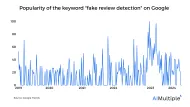Cryptocurrency Sentiment Analysis in 2024: An In-Depth Guide
Source: Medium
Figure 1. The association of Bitcoin prices with the sentiment in users’ tweets
The cryptocurrency market has grown exponentially recently, from 5 million owners in 2016 to 300+ million in 2021. We see a similar trend in the NFT marketplace as the number of users was 670,000 in 2020 and increased to 44+ million in 2022. However, investing in cryptocurrency can be risky as there can be extreme fluctuations in the market. For instance, in 2022, while Bitcoin lost more than 60% of its value, Dogecoin lost 55% of it, putting investors in a difficult position.
As the cryptocurrency market does not have a central governing authority, the prices can change depending on the sentiment of the public, natural disasters in a country, global news, crises between countries, etc.
In this article, we explain how sentiment in the reviews is correlated with the price movements of cryptocurrencies, how to analyze cryptocurrency sentiment, and the challenges of cryptocurrency sentiment analysis together with solutions.
What is cryptocurrency sentiment analysis?

Figure 2. Self-updating fear and greed index of the crypto market
Research reveals that people produce more than 100 MB of data every minute, including insights regarding their feelings and thoughts on various topics. Some of these reviews, feedback, social media posts or blog posts include thoughts on the cryptocurrency markets.
The sentiment in consumers’ reviews, feedback, social media posts, or blog posts correlates with market price movements. For instance, when Elon Musk added the Bitcoin hashtag to his Twitter biography, Bitcoin prices rose from 32,000 to 38,000 in a couple of hours.
Source: Vox
Figure 3. Elon Musk’s tweets on cryptocurrency and how Bitcoin prices change accordingly
So, sentiment analysis can be a great way to find where and when to invest in cryptocurrency. For example, analyzing the sentiment in customers’ or thought leaders’ tweets can provide great insights into the association between cryptocurrency prices and public sentiment.
How to conduct cryptocurrency sentiment analysis?
1. Collect data related to cryptocurrencies, such as investors’ reviews, texts including public sentiment, tweets mentioning crypto, etc.
2. Gather historical price changes of various cryptocurrencies
3. Clean the dataset to get rid of the unrelated items
4. Label the content in the dataset based on emotional tone as either negative, positive, or neutral, either manually or using automated tools.
5. Train your model with a labeled dataset
6. Evaluate the performance of your model
You can also check our data-driven list of sentiment analysis services.
What are the influential factors on cryptocurrency prices?
There are certain factors influencing cryptocurrency prices:
- Supply, demand, and mining difficulty
- Market trends
- Macro-economic factors
- S&P 500
- USD/EUR exchange rate
- Political issues in a country (e.g., Venezuela)
- Twitter mentions
- News sentiment
- New regulations by the governments
- Investors’ opinions
To have reliable results in sentiment analysis, it is crucial to determine the right dataset and clean it accordingly. However, this can be challenging considering the noise in the customers’ feedback or reviews.
Source: IEEE
Figure 4. Some examples of positive and negative labeled Tweets during the creation of the dataset for sentiment analysis
Challenges of cryptocurrency sentiment analysis
- Models that are not trained in the terminology of the crypto market may yield misleading results.
- Identifying bot accounts can be challenging, especially if the dataset is not labeled manually.
- The number of tweets sent regarding cryptocurrency by bot accounts is estimated to be almost 15%, distorting the sentiment analysis results.
How to overcome these challenges?
- Generate a holistic approach by combining polarity, emotion, and aspect-based analysis.
- Train a domain-specific model that includes the terminology of the crypto market.
- Detects bot accounts using neural networks and contextualized representations of each text. A recent study shows that neural networks achieve 82% accuracy in identifying bots.
You can also read our comprehensive article on sentiment analysis challenges and their solutions.
If you need any assistance, do not hesitate to reach us:
This article was originally written by former AIMultiple industry analyst Begüm Yılmaz and reviewed by Cem Dilmegani.

Cem has been the principal analyst at AIMultiple since 2017. AIMultiple informs hundreds of thousands of businesses (as per similarWeb) including 60% of Fortune 500 every month.
Cem's work has been cited by leading global publications including Business Insider, Forbes, Washington Post, global firms like Deloitte, HPE, NGOs like World Economic Forum and supranational organizations like European Commission. You can see more reputable companies and media that referenced AIMultiple.
Throughout his career, Cem served as a tech consultant, tech buyer and tech entrepreneur. He advised businesses on their enterprise software, automation, cloud, AI / ML and other technology related decisions at McKinsey & Company and Altman Solon for more than a decade. He also published a McKinsey report on digitalization.
He led technology strategy and procurement of a telco while reporting to the CEO. He has also led commercial growth of deep tech company Hypatos that reached a 7 digit annual recurring revenue and a 9 digit valuation from 0 within 2 years. Cem's work in Hypatos was covered by leading technology publications like TechCrunch and Business Insider.
Cem regularly speaks at international technology conferences. He graduated from Bogazici University as a computer engineer and holds an MBA from Columbia Business School.
To stay up-to-date on B2B tech & accelerate your enterprise:
Follow on
Comments
Your email address will not be published. All fields are required.